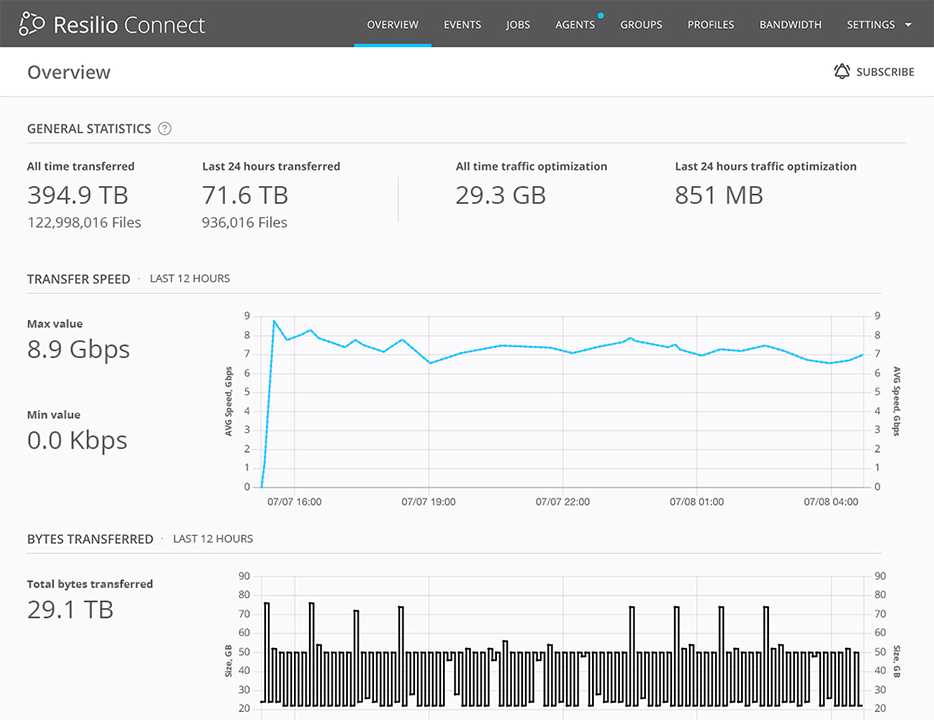Like most point-to-point file transfer tools (such as Signiant and Filecatalyst), IBM Aspera provides a solid replacement for FTP and other TCP-based approaches to file transfer.
What’s unique about Aspera (prior to Aspera Sync) is that they were an early innovator in cross-platform, WAN optimized file transfer. They were well ahead of Signiant and Filecatalyst in that regard. And media & broadcast companies were early adopters of the technology and continue to use Aspera in their digital workflows.
This blog will mainly address Aspera Sync. But also touch on where Aspera does well, not so well, and when and where to consider Resilio Connect as both an Aspera FASP and Aspera Sync alternative. The bottom line is that, if you need to reliably distribute and synchronize files or collaborate on large digital assets for remote work—you should be speaking with Resilio.
Keep in mind that Aspera Sync is not useful for most remote work use cases, where large, high-value digital assets need to be synchronized behind the scenes by contributors in a person to person fashion.
For example, in the post production world, a video editor working on a 4K or 8K asset, doesn’t want to be bothered waiting on an upload (either back to the office or the cloud) whilst their edits percolate slowly out to other remote contributors. Delays like that impact lead times. Instead, Resilio Connect enables everyone on a team to work collaboratively–from any location and across any network–using their device of choice such as macOS or Windows.
So for remote work and other work from anywhere remote ops, Resilio is a game changer.
Resilio Connect offers unprecedented speed and simplicity. Contributors are able to edit and efficiently sync changes immediately to as many other team members as needed. This can be done in real-time or on-demand; some people may choose to work offline until they’re reconnected to a network.
Internally, we refer to this capability as real-time N-way (many-to-many) synchronization. It’s a killer app that companies like Skywalker Sound, 7 Wonders, and others in the media space are raving about.
This piece doesn’t cover much on remote work—but please do get in touch if you need an easy, fast, secure, and workflow-friendly solution for remote work.
Background on IBM Aspera
Aspera’s core innovation is its patented, UDP-based FASP® transport. The transport is loaded at the OS level so it runs on a variety of operating systems. Aspera FASP runs on Windows, Linux, MacOS, FreeBSD, and Isilon OneFS; it’s not clear if Aspera Sync has this same level of OS support.
Aspera FASP is purpose-built for securely transferring large bulk data sets one-way—point-to-point, from one endpoint to another endpoint—across wide area networks (WANs). Over the years, they’ve added support for streaming file bits (not to be confused with real-time streaming data for event processing) and, finally, file synchronization—with Aspera Sync.
Aspera’s product line includes a diversity of products for B2B file collaboration, ingest, and distribution; and through Aspera Orchestrator, a rules-based framework that provides extensible functionality for multi-step workflows and automation.
For years, well before the IBM acquisition, Aspera’s customers had been asking for a sync capability. So the company developed Aspera Sync. It’s not clear if there will be a next-generation version of Aspera Sync—but the current version has some issues.
Aspera Sync: The Good, Bad, and Ugly
The good: Aspera Sync utilizes FASP as the underlying high-speed end-to-end transport for WAN optimization. The one-way sync performance tests against Rsync that IBM publishes show that Aspera is exponentially faster than Rsync when tested over high-latency longhaul links. This makes sense: Rsync relies on TCP, chokes and stumbles on latency, and was never designed for synchronizing large files over distance. “Maximum speed” is a term often used by Aspera to represent full-utilization of allocated WAN bandwidth between computer systems.
Another good point, like Aspera’s other transfer products is that they are cross-platform (and runs on Microsoft Windows, Apple Mac, etc.), secure, use SSH authentication, and support a variety of providers’ cloud storage offerings. Aspera runs on a variety of operating systems and mobile apps (Windows, Mac, iOS, Android, etc.). Unlike Dropbox, Google Drive, Box, and other on-demand proprietary file management apps, Aspera gives you the flexibility to use a variety of devices and data center and cloud storage options. And workflow automation is provided through features like Hot Folders, APIs, and scripting. But if you’re a small business, or not in the broadcasting or media space, you may not be interested in such complicated frameworks.
The bad: Like Unison and other two-way bidirectional sync tools, conflicts may arise with Aspera Sync when a file or directory changes or is renamed before the synchronization process has completed. For example, if a file is changed on both sides at the same time, the latest version of the file may not be known. When these conflicts arise, Aspera Sync does not update the files and reports the conflict as an error message. The administrator must manually resolve the conflict, delete one of the files, and run the sync job again. It’s intrusive and unreliable, to say the least. From a management perspective, it looks as bad if not worse than other open source bidirectional sync offerings such as Unison or Osync. (In theory, Lsyncd can be setup for bidirectional sync, too.)
Aspera Sync should provide better access controls and easier file and metadata management of file permissions (NTFS ACLs, extended attributes, etc.) for transferred and synchronized files. (With Resilio Connect, this is a check-box. Many customers use Resilio Connect for ongoing data migration.)
To be fair, Resilio Connect can run into synchronization conflicts, too. But in the Resilio model there are conflict avoidance best practices and policies in place to automatically respond to conflicts and preserve data integrity. Priority peers (endpoints) can be set to arbitrate conflicts. And there’s a feature to resolve file naming conflicts which protects files in these circumstances. Resilio also offers archiving accidentally deleted files, as well as files with naming conflicts.
The ugly of Aspera Sync: Like many basic point-to-point replication and sync tools (Rsync, Unison, et al) Aspera Sync is severely limited. For me the hardest pill to swallow is that Aspera Sync is over advertised as multi-directional; it’s not truly multi-directional. It is multi-threaded (which is good) but it is point-to-point. Like Unison, it can be used in a bidirectional mode and in a hub-and-spoke. The upside is that a hub and spoke is useful in some situations: but the hub is always a performance bottleneck and single point of failure.
And the “HA” mode that Aspera offers is active-passive at best and adds 50% cost to the endpoint license.
According to the Aspera documentation, to run Aspera Sync in multi-directional mode, a separate (unique) session—an async process—is required for each remote peer. That means if you have 10 remote servers you need to synchronize, you need 10 separate Aspera Sync processes running on the source host!
Put another way, according to the Aspera documentation: “In multi-directional scenarios, one Aspera Sync session (one async process execution) is required for each remote peer with which synchronization is needed. Any number of async processes can be run concurrently, and any number of peers can be synced concurrently. The model assumes that peers are synchronizing in an acyclic graph topology, meaning that a downstream peer is not configured to sync “back” in a loop to an upstream peer.”
For this to work, a hub-and-spoke is stacked, where the hub (A) could sync one-way to servers B and C; once those jobs complete; servers B and C sync to D and E; and so forth. It sounds complicated and brutal to implement. Good luck.
In other situations, even on IBM’s own storage like GPFS, Aspera Sync can not pick up change notifications. According to page 4 of the IBM Red Book, Integration of IBM Aspera Sync with IBM Spectrum Scale, IBM Aspera Sync does not track changes to files and blocks in the source directory in real time and (thus) cannot become overloaded by too many changes. However, IBM Aspera Sync transfers entire files. Therefore, even if a small portion of a large file changed, the next transfer copies the entire large file.
Aspera Sync vs Resilio Connect
If you value simplicity, reliability, speed, and predictability—Resilio Connect is hard to beat. We’re currently offering a complimentary evaluation. And many of our customers in the media & creative industries are loving Resilio Connect for remote work, reliable bidirectional synchronization, live event coverage–and more.
Please contact us for a live demo and discussion.
Resilio Connect is The Best Aspera Sync Alternative
Resilio Connect is the most scalable and reliable Aspera Sync Alternative. Resilio Connect syncs faster, more efficiently, and more reliably than Aspera Sync—and scales sync jobs in any direction—one-to-one, two-way, one-to-many, many-to-one, or many-to-tomay—across as many endpoints (peers) as needed. Resilio excels at synchronizing files (of any size and type, and many millions of files) in real-time and across any network.
And when it comes to comparing Aspera Sync to Resilio Connect for bidirectional file synchronization, there’s no contest. Resilio Connect is a far superior Aspera Sync alternative. Resilio Connect is also peer-to-peer. Using Resilio, the sync job is parallelized across peers participating in a sync job.
This can be one- or two-way (bidirectional), one-to-many, many-to-one, or N-way. There are so many advantages of Resilio Connect over Aspera Sync. These include:
- Work from anywhere using devices you already own. There’s no cumbersome software to manage and troubleshoot. Your creative teams and other users simply work with files as they normally would—in Apple Finder, Windows Explorer, or other document management tools and DAMs.
- Built in WAN Optimization: Resilo offers a P2P-enabled, UDP-based WAN optimization capability called Zero Gravity Transport (ZGT). While Aspera FASP is UDP-based and quite awesome, it is only useful between 2 systems (2 endpoints) at once, or when used in a hub and spoke. Resilio ZGT scales to thousands of endpoints concurrently in a peer-to-peer design.
- Reliable bidirectional synchronization. Resilio enables nearly any number of systems to participate in bidirectional sync across sites. There are built in policies and best practices to resolve conflicts and ensure data integrity is always preserved.
- Scale distribution and sync in any direction. Resilio Connect makes it easy to send and distribute or synchronize files across many endpoints at once. The big advantage of Resilio is predictability. You can synchronize hundreds of millions of high-value digital assets across thousands of systems in about the same time as synchronizing two systems.
- Bullet proof reliability and HA. Resilio has no SPOFs and all servers and sites are protected with active-active high availability.
- Ease of use: A sync job is super easy to set up in the Resilio management console. Our customers love that you can simply set-it-and-forget. And the management console makes it easy to manage thousands of agents globally, through a single pane of glass.
Aspera Sync vs. Resilio Connect: Comparison
This table provides a summary of which large file transfer and sync software solution is best for each use case, Aspera or Resilio Connect (an Aspera alternative). A more detailed explanation of each use case follows.
| Capabilities | Aspera Sync | Resilio Connect |
| Cross-platform | ✔ | ✔ |
| WAN Optimization | ✔ | ✔ |
| Automation via scripting and APIs | ✔ | ✔ |
| Peer-to-peer (P2P) architecture for parallel synchronization of any size payload | ✔ | |
| Active-active high availability across endpoints without additional cost | ✔ | |
| Secure file transfer and synchronization with encryption | ✔ | ✔ |
| Easy to sync updates any time from one contributor to many contributors | ✔ | |
| Collect files from multiple sources to a single target | ✔ | ✔ |
| Transfer or sync files to several teams concurrently | ✔ | |
| One-way sync | ✔ | ✔ |
| Two-way sync | ✔ | ✔ |
| Reliable two-way sync with conflict resolution controls | ✔ | |
| Real-time sync to several teams and locations in parallel | ✔ | |
| Scalable multidirectional sync running on multiple systems in parallel | ✔ | |
| Selectively and efficiently download and sync files from and to the cloud, on-demand | ✔ | |
| Smart offline work from anywhere and sync on-demand or automatically when back online | ✔ |
Use Cases for Aspera Sync vs. Resilio Connect
Collect and transfer a few large files from team A to team B
(Tie)
Aspera and Resilio Connect are both capable solutions when you need to send a few files between two locations over the wide area network (WAN). They both have acceleration technology and are much faster and more reliable than FTP for large data sets and big data. Resilio Connect has an advantage when working over the local area network (LAN) since it can fall back to TCP/IP, which delivers high performance while being less aggressive to local traffic.
Transfer a few files to external partners
(Aspera Wins)
Aspera Connect (different from Aspera Sync) is a good tool when you need to send a number of files or do file sharing with external partners, have a nice UI, ability to leverage WAN optimized speed inside a browser and have available bandwidth, Aspera is the superior solution.
Resilio Connect is great when you need to collect and consolidate files from multiple locations to a single, central location within the same company.
Real-time sync to several teams at once
(Resilio Connect Wins)
Resilio Connect outperforms Aspera Sync when you need to transfer or sync files either in real-time or on-demand among teams of collaborators.
Resilio Connect is fast, easy, secure, and workflow friendly. An editor or contributor working on a large digital asset can make changes and rapidly sync those changes with as many other contributors as he or she chooses.
The Resilio technology combines its peer-to-peer design with its WAN optimized ZGT protocol and efficiently sends file changes concurrently and independently to several destinations. These destinations could be other individuals located anywhere, or servers or cloud instances located anywhere. Simply increasing bandwidth speeds up delivery times.
Synchronize files across locations
(Resilio Connect Wins)
Aspera Sync and its FASP protocol is more like a WAN-optimized Rsync than Resilio Connect. When you need to keep several geographically distributed servers in sync, Resilio Connect is the clear winner and provides an excellent Aspera Sync alternative. Connect can easily and efficiently track changes on hundreds of millions of files for changes and deliver changed files extremely fast to multiple locations.
Workflows can be automated through a central management console. The works very well with cloud, on-premise geographically distributed servers or any combination.
Sync files from one to several locations (one-to-many)
(Resilio Connect Wins)
Aspera FASP is a strong point-to-point one-way large data transfer solution; Aspera Sync is at best bi-directional with caveats, such as arduous conflict resolution.
Resilio Connect, by contrast, is based on true peer-to-peer, omni-directional architecture. Resilio provides concurrent and storage-independent data transfer to several destinations at once. All peers collectively work on the sync job which means it’s exceptionally fast to sync files across many endpoints at once.
Sync to/from cloud/private object storage
(Resilio Connect Wins)
There are many cloud sync scenarios when you need to sync efficiently between on-prem and the cloud or among your teams and the cloud. A key consideration is the ability to efficiently download files on-demand. Resilio Connect, through Transparent Selective Sync, offers an efficient way to browse for and download only the needed files.
Resilio Connect supports any S3-compatible cloud object storage as well as cloud file storage. Resilio Connect outperforms Aspera in the following, more complex use cases:
- Upload data to the cloud and deliver to another location
- Create a master copy of the project and distribute it between teams
- Distribute assets from the cloud to geographically distributed teams
- Connect any local server or NAS to the cloud
- Download files selectively and efficiently for use on-prem and in other remote locations.
Active-active high availability
(Resilio Connect Wins)
Aspera Sync offers a basic active-passive failover for high availability. Aspera Sync is not clustered and not peer-to-peer. It’s point-to-point. In a hub and spoke, for example, the hub is a single point of failure. In any transfers, each endpoint (unless configured for HA) is a single point of failure. Resilio Connect is peer-to-peer. If any peer fails, or there’s a failure in the network, the transfer or synchronization process continues undisturbed until the job is completed.
Summary
When it comes to remote work and synchronizing files from any location and workspace, Resilio Connect is the way to go. Moreover, you’ll be hard pressed to find a better Aspera Sync Alternative than Resilio Connect for scaleable one-to-many distribution and synchronization.
Resilio Connect is a great solution for:
- Remote collaboration for remote work, hybrid work, and work from anywhere. Using Resilio is fast, easy, and workflow friendly. Simply install the agent on your device to sync digital assets of any size and type.
- Dependable file sync for many contributors, across as many servers and locations as needed. Resilio is the leader in reliable bidirectional synchronization. You can have as many endpoints as needed, spanning two or more sites.
- Predictable, scale-out distribution and synchronization: Resilio Connect can both distribute and sync files many-to-one, or N-way. Resilio’s P2P architecture sends a single file to as many other places as needed. It takes the same time to distribute or sync files across hundreds of servers as it does to 2 servers.
- Active-active high availability and bulletproof reliability: Resilio can use any network and is more resilient than the competition. There are no SPOFs using Resilio!
Learn more about Resilio Connect and how it outperforms Aspera in most use cases. Please schedule a demo to find out.





